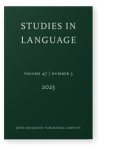Vol. 47:3 (2023) ► pp.526–570
Progressives in present and past
This study investigates the relationship between progressive patterns and present and past time reference. First, it looks at the shared distribution of more than 90 progressives in two parallel corpora and discusses the characteristics of these contexts. It is shown that while progressives are used for dramatic and topical events in the present, they are typically used as backgrounding, supportive material in the past. Second, it is shown that progressives generally have more occurrences in contexts with present time reference than past, this is especially true for progressives with many uses, i.e. more grammaticalized progressives. And third, a number of progressives temporally restricted are presented. Two historical explanations for these restrictions are provided, both of which result from the higher frequency of present uses over past.
Article outline
- 1.Introduction
- 2.Methodology
- 2.1The two corpora
- 2.1.1The Parallel Bible Corpus
- 2.1.2The TED corpus
- 2.2The two samples
- 2.2.1Identification of progressive grams in the PBC
- 2.2.2Methodological issues regarding automatic extraction
- 2.2.3Identification of progressive grams in the TED corpus
- 2.1The two corpora
- 3.Shared distribution of progressive grams
- 3.1Contexts with present time reference
- 3.2Contexts with past time reference
- 3.3Features increasing the likelihood of the use of a progressive
- 4.Temporal asymmetries
- 4.1Temporal preference
- 4.1.1Grams with no temporal preference
- 4.1.2Grams with a majority of present uses
- 4.1.3Grams with a majority of past uses
- 4.2Temporal restrictions
- 4.2.1Restriction to present time reference
- 4.2.2Restriction to past time reference
- 4.1Temporal preference
- 5.Conclusion
- Notes
- Abbreviations
-
References
For any use beyond this license, please contact the publisher at [email protected].
